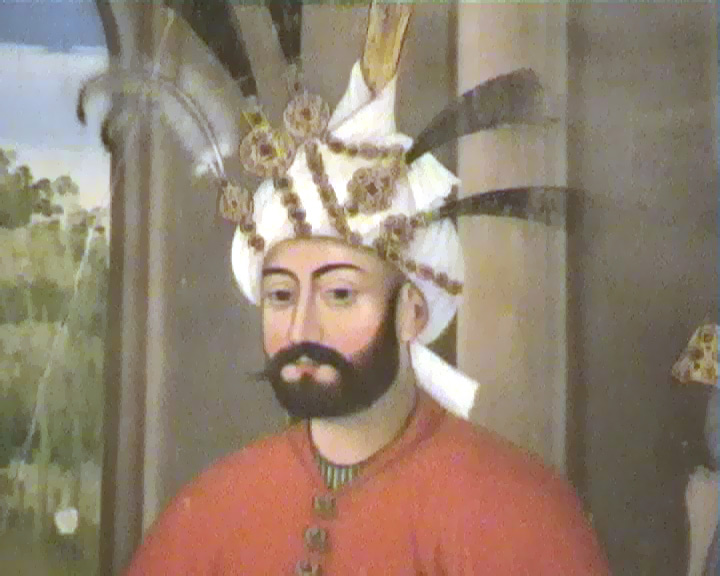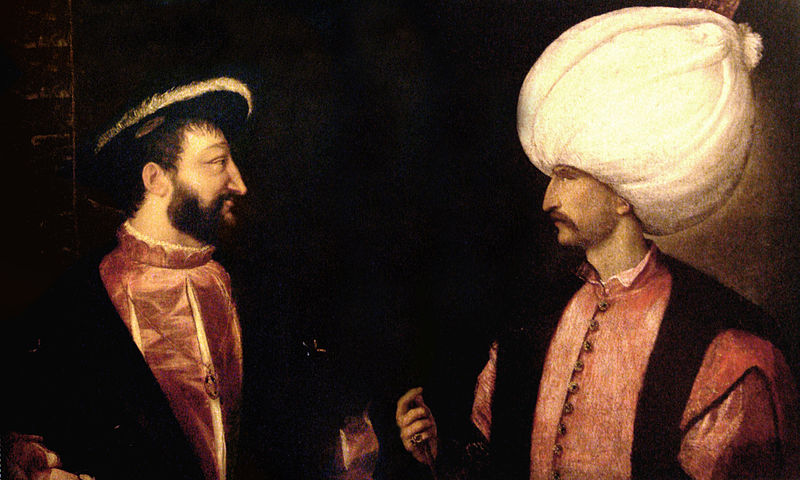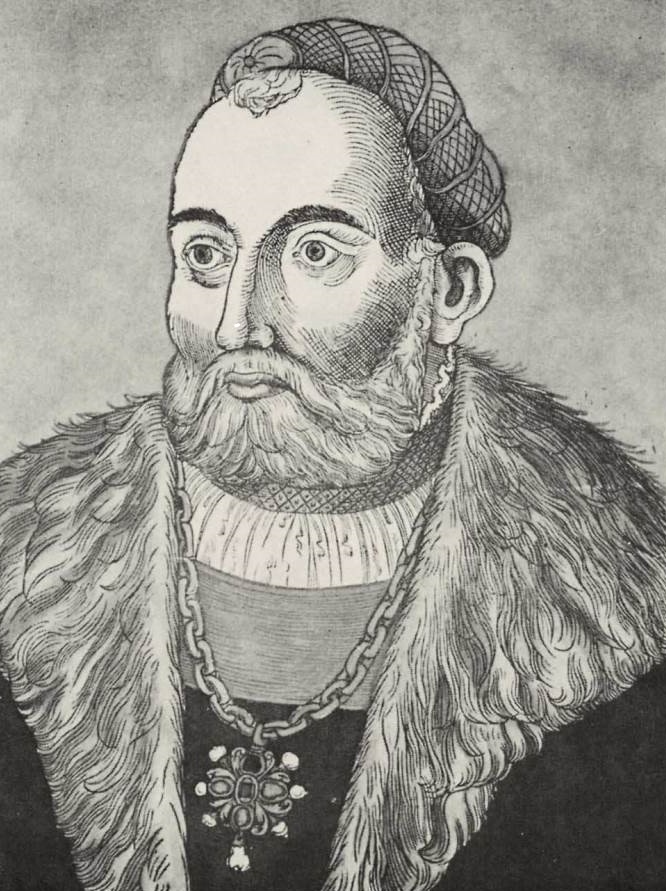War in the Mediterranean
 |
| Admiral Doria |
In
retaliation to the exploits of Admiral Doria in Greece and in opposition to
Charles V’s ambitions in the Mediterranean Suleiman appointed Khair ad-Din,
better known as Barbarossa, as the admiral of his fleet.
Barbarossa
exploited the raiding talents of the Turkish corsairs[i]. He was an advocate of
working with France to suppress Spanish naval ambitions in the Mediterranean.
In 1536 a Turco-French treaty was signed, with secret mutual defence clauses.
François 1 hoped that the Turks would be able to assist in his fight for
territory in northern Italy.
In 1534
Barbarossa sailed out with his fleet to ravage the coast of Italy and then on
to Tunis; on his arrival such was the power of his name that the ruler, Muley
Hassan, fled. Strategically important Tunisia was annexed to the Ottoman
Empire. Charles V sent an envoy to Tunis, almost immediately, with instructions
to raise a revolt, with the support of the deposed ruler, against the Turks.
The plot was uncovered and Charles’ agent was put to death.
In the
summer of 1535 a Spanish fleet, under the command of Doria, landed at Carthage.
They besieged the fortress that guarded the entrance to Tunis harbour and after
24 days the walls were breached. Barbarossa prepared to defend the city, but
was hampered by the break-out of thousands of Christian prisoners, who captured
the arsenal. Barbarossa fled as Muley Hassan was reinstated as ruler. |
| Barbarossa |
Barbarossa
fled to Bone, on the coast, where his reserve fleet awaited. After reinforcing
the fleet Barbarossa attacked the Balearic Islands. Flying Spanish and Italian
flags the fleet sacked Mago[ii], carrying off captives
and treasures to Algiers.
In 1536
Suleiman instructed Barbarossa to build a new fleet of 200 ships, which sailed
the following year to attack Italy; in association with an army sent from
Albania under Suleiman’s command. The plan counted on the intervention in the
north by François, but unfortunately the French king had decided that for the
present a truce with the Holy Roman Empire was more advantageous for his
country.
Instead of
the planned convergence of army and navy Barbarossa attacked the Venetian
islands in the eastern Mediterranean, who had been annoyed by the preferential
treatment given to the French in trade matters. Barbarossa returned to Istanbul
loaded with treasure to lay at Suleiman’s feet.
‘The Pasha dressed two
hundred boys in scarlet, nearing in their hands flasks and goblets of gold and
silver. Behind them followed thirty others, each carrying on his shoulders a
purse of gold; after these came two hundred men, each carrying a purse of
money; and lastly two hundred infidels wearing collars, each bearing a roll of
cloth on his back.’[iii]
In 1538 the
fleet under Barbarossa defeated a crusader fleet commanded by Doria at Preveza.
The stand-off between Doria and Barbarossa was to continue for many years. In
1541 Charles V took advantage of Barbarossa’s absence in Istanbul to attack
Algiers. The attack was foiled by a hurricane. In 1543 Barbarossa was sent to
attack Sicily and the western coast of Italy. When the fleet reached the French
Mediterranean coast they were allowed to use Toulon as their naval
headquarters.
War with the Safavid
When Shah Tahmasp
of Persia ascended to the Safavid throne in 1524 Suleiman wrote a revealing
letter
‘If there still remained a
spark of honour and ardour in a personality corrupted by error, you would long
ago have vanished. I have decided to bear arms to Tabriz and into Azerbaijan
and to pitch tent in Iran and Turan, in Samarkand and Khorosan.’[iv]
Shah Tahmasp
It was not
until 1532 that Suleiman was finally able to turn his attention to the irritant
in Baghdad. The divide between the Sunni and Shiite factions of Islam was
bitter and Sunni Moslems were persecuted within the boundaries of the Safavid Empire.
As Suleiman saw himself as a protector of Islam his duty must have seemed clear
to him. And there was reason to act.
The Bey of
Bitlis[v] placed his territory under
the protection of the Shah. In a counter-action the governor of Baghdad sent the
keys of the city to Suleiman, but was then assassinated. Suleiman believed
that, as possessor of the keys, he was the ruler of Baghdad. After the
assassination Tahmasp had retaken the city but this action was seen in Istanbul
as dragging the city back down into the Shiite heresy.
In the
autumn of 1533 Ibrahim took an army to annex Azerbaijan, en route he was sent
the head of the former Bey of Bitlis. Several fortresses surrendered and
Ibrahim then spent the winter at Aleppo. In the spring the army marched on
Baghdad and Ibrahim entered the capital of the Safavid Empire on 16th
July 1534. The city was a shadow of its former self. In 1437 one writer
commented
‘Baghdad is in ruins. There
are neither mosques, a faithful congregation, call to prayer nor souks; most of
the palm trees are dried out. It cannot be called a town.’[vi]
The Turkish
system of administration was set up in Mesopotamia. Janissaries and Sipahis
were garrisoned and a governor installed.
In 1535
Suleiman led his army against Tahmasp in Tabriz[vii]. The Safavid Emperor
retreated into the hills; while Suleiman took possession of the town but left
after two weeks. The campaign although glorious, was costly in terms of men and
mounts; circa 30,000 men died[viii]. Suleiman returned to
Istanbul in January 1536, his army having suffered guerrilla attacks from the
Persians throughout the return journey.
In 1538 the
Emir of Basra submitted to the Ottomans, who were now masters of the Persian
Gulf as well as the eastern Mediterranean and the Red Sea. Renewal of the war
in Europe saw a Safavid counter attack and Suleiman’s army marched against
Iran. The war was finally resolved by treaty on 29th May 1555,
whereby Baghdad was to remain in Ottoman hands.
Death of Ibrahim
Francois 1 with Suleiman
By the
beginning of 1536 Suleiman and Ibrahim were back in Istanbul. On 18th
February Ibrahim signed, in Suleiman’s name, the treaty with France. Less than
a month later he was dead, garrotted in his bedroom in the Topkapi Palace. Ibrahim
had fought for his life, evidenced by the bloodstains and torn clothing.
The job of
Grand Vizier had always ensured a high mortality rate for its holders. Suleiman
was aware of Ibrahim’s arrogance and his boasting of his usurpation of his
master’s authority.
‘Although I am the Sultan’s
slave, whatever I want is done. On the spur of the moment I can give kingdoms
and provinces to anyone I like, and my master will say nothing to stop me. Even
if he has ordered something, and I do not want it to happen, it will not
happen; and if I command something, and he happens to have commanded the
contrary my wishes and not his are obeyed. I can make war and I can grant
peace. I can make men rich.’[ix]
Ibrahim had
already brought about the death of the Minister of Finance, Iskender Chelebi,
on charges of misuse of public monies and intrigues against the Sultan. After
the minister’s death Suleiman persuaded himself that Iskender was innocent. Before
his death Iskender had put pen to paper to accuse the powerful Ibrahim of
conspiring against Suleiman.
It is
believed that Roxelana, jealous of his influence, intrigued against Ibrahim and
it was during 1536 that the Seraglio was moved into the Topkapi at Roxelana’s
request. This move increased the influence of those living in the Seraglio. Suleiman’s
mother, a protector of Ibrahim, had died the previous year and Roxelana may
have used her access to the Sultan to poison Suleiman’s mind against his Grand
Vizier.
As a slave
all Ibrahim’s possessions reverted to his master on his death.
Hungary Again
John Zapolya
In 1540 John
Zapolya, Suleiman’s choice for king of Hungary, died; and Ferdinand marched
into Hungary, with as many troops as he could raise on short notice. Zapolya
and Ferdinand had recently concluded a secret treaty allowing Ferdinand to take
the kingdom in the event of Zapolya dying without issue. Hearing of the treaty
Suleiman commented
‘These two kings are
unworthy to wear crowns, they are faithless men.’[x]
On his
deathbed Zapolya was informed of the birth of a son and the new king’s
ministers appealed to Suleiman to support the new-born infant, King John
Sigismund. Suleiman agreed in return for the payment of tribute.
That winter
the Ottoman army prepared its return to Buda. Frederick had been repulsed from
the city by Stephen’s adherent, a monk named Martinuzzi who had previously been
his father’s chief adviser. Suleiman entered Buda on 2nd September
1541, having informed John Sigismund’s mother that he was going to annex
Hungary. This decision was partly based on the difficulties that John Sigismund
would face trying to hold onto his crown faced with an enemy in his prime and
bankrolled by Charles V. Buda and its surrounding territory was turned into a
Turkish province.
Ferdinand
sent envoys again demanding the return of Hungary. To which Suleiman’s Grand
Vizier replied
‘Do you believe that the
Padishah is out of his mind, that he would relinquish what he has won for the
third time with his sword?’[xi]
In 1543
Suleiman again marched into Hungary and captured Gran. It was fortified as the
north-western outpost of the Ottoman Empire. His armies then turned and
conquered much of the rest of Hungary which was to remain under Turkish rule
for the next 150 years.
The next
years saw another campaign in Persia, more land grabs in Hungary and in 1553
Suleiman’s final campaign in Persia following Persian attacks on the Turkish
borders. Suleiman’s troops marched across the River Euphrates to take the fight
to the enemy. They laid waste to Persian lands, but the Turkish supply lines
were over-extended and eventually the two sides agreed a treaty.
Bibliography
Suleiman the Magnificent – André Clot,
Saqui Books 2012
Lord of the Horizons – Jason Goodwin,
Henry Holt & Co 1998
The Ottoman Empire – Halil Inalcik,
Phoenix 1997
The Ottoman Empire – Patrick Kinross,
Folio Society 2003
Safavid Iran – Andrew J Newman, IB
Tauris & Co Ltd 2006
The Ottoman Empire – Andrina Stiles,
Hodder & Stoughton 1991
En.wikipedia.org
[i] He had previously been their chief, with forty ships under his command



No comments:
Post a Comment
Note: only a member of this blog may post a comment.